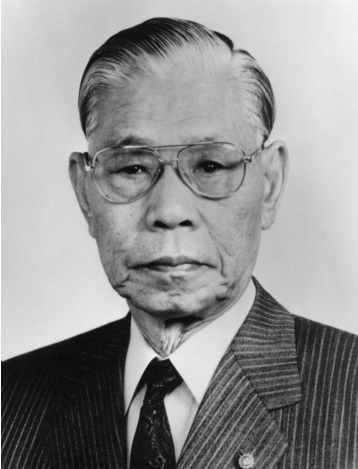
In 1986, my grandfather, Koichiro Yasu (安 弘一郎) wrote a book about the origins of my family and Jyujiya Securities Co. Ltd., (十字屋証券) our family brokerage firm, which was originally started by my great grandfather, Tsunesaburo Yasu (安 常三郎), in 1924. Late in life, Koichiro was diagnosed with liver cancer and knew his remaining life was not long. Instead of going after his bucket list, he wrote a book to share his experiences with other family members and people in the brokerage industry. We privately published the book and distributed it at his funeral (so you won’t find it on Amazon).
The title of the book is “Memoir of a Snail”. The book started with the following Haiku by Seibo Kitamura (北村西望, 1884-1987), a Japanese sculptor.
Tayumazaru (たゆまざる)
Ayumi osoroshi (あゆみ恐ろし)
Katatsumuri (かたつむり)
Tirelessly onward
Remarkable progress
The Dao of a snail
Mr. Kitamura created the Peace Statue at the Nagasaki Peace Park. When he was making the statue, he found a snail on the ground which looked like it was not moving. The next morning, he found the same snail on top of the statue. He recognized that untiring small efforts will make a huge difference over time. His success did not come easily. So, I guess he saw himself in the snail.
My grandfather also thought his half century experience in the brokerage industry was like the methodical walk of the snail. He was the kind of person who preferred humility and stability. He never over-expanded the business nor took undo-investment risk. He indirectly learned from his father, who was his polar opposite. Tsunesaburo was a big speculator and always reached for what he could not afford. I respect him since his drive and luck became the basis of our family business. But I also respect my grandfather since he was the guy who kept us in business.
The book introduced a couple of investment successes from both my grandfather’s and great grandfather’s days. Tsunesaburo was a journalist covering the markets before getting into the brokerage business. I guess he took advantage of his special relationship with journalist friends and made a fortune by shorting popular speculative stocks before the Asahi newspaper put up an article that the government was considering delisting some of them. The article proved to be correct, and years later he made enough money to become a member of the Tokyo Stock Exchange.
Koichiro’s trade of his life was an arbitrage trade. A few years after World War II, the government decided to issue a new yen and freeze deposits to cope with high inflation. To convert old yen to new yen, people needed to deposit cash to their bank accounts within about one month after the announcement. At that time, a common way of saving money was storing bills under mattresses or in drawers. Also, people were only allowed to withdraw 300 new yen per month from their bank account, which was barely enough to support daily needs (the average monthly salary of a public worker was about 500 yen). Therefore, most of people’s savings were stuck in bank accounts and losing purchasing power due to the high rate of inflation. Prices were rising about 1000% every 3 months.
Koichiro and a few other brokers found a loophole: buy a stock in the old yen, and then turn and sell it for the new yen. Although the Tokyo Stock Exchange was occupied by the GHQ and officially closed, brokers set up aisles in front of the exchange building and actively traded securities. My family’s firm made 20% every time they did this trade for clients. New clients who learned of the loophole from word of mouth kept coming to Jyujiya with their old yen bills.
When the stock exchange officially reopened, the Ministry of Finance put a very high capital hurdle requirement to be a member of it. Jyujiya had enough capital to maintain its membership because of the new yen/old yen trades.
Koichiro preferred such arbitrage transactions throughout his career. The book also introduced profitable trades related to dismantling the Zaibatsu. For example, if you bought shares of one of Mitsubishi’s chemical companies, you could convert it into shares of three new spun-out entities. Since these spin-outs traded at a premium, there were large spreads to be captured. In many cases, shares of Zaibatsu companies were sold through auctions by a government body to licensed brokers. Also, there was no Bloomberg terminal then, so a broker’s location provided great advantage for arbitrage transactions. Koichiro actively participated in such auctions.
At the end of the book, my grandfather wrote a message to successors of the family business: as Japanese equity markets face increased globalization and deregulation, boutique firms like Jyujiya will have to find a new raison d’être. My family decided to exit the brokerage business right before the financial crisis. Around the same time, we started VARECS as a boutique investment firm. We thought the investment management business was more suitable for boutique firms to be differentiated and succeed.
Value investing and compounding capital is a lot like the crawl of a snail, I believe. As we write regarding our philosophy on this renewed website, we try to invest in high quality companies at a price that has some margin of safety. I think the returns of our portfolio will not be a homerun in any particular year. We instead try to achieve decent returns while preserving capital over the years. I still have 30 more years to reach the age my grandfather was when he wrote his book. We wish to compound capital at attractive rates for 30 years — like the snail which reached the top of the statue.
Jiro Yasu, Portfolio Manager

